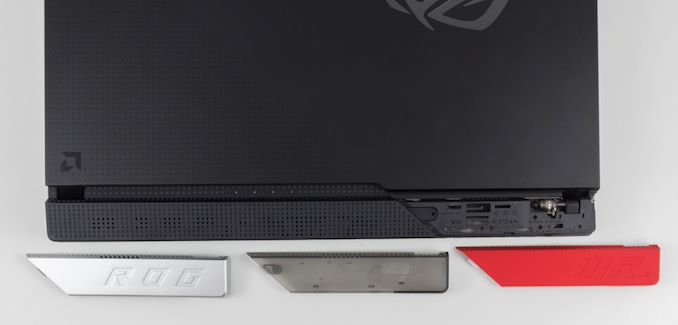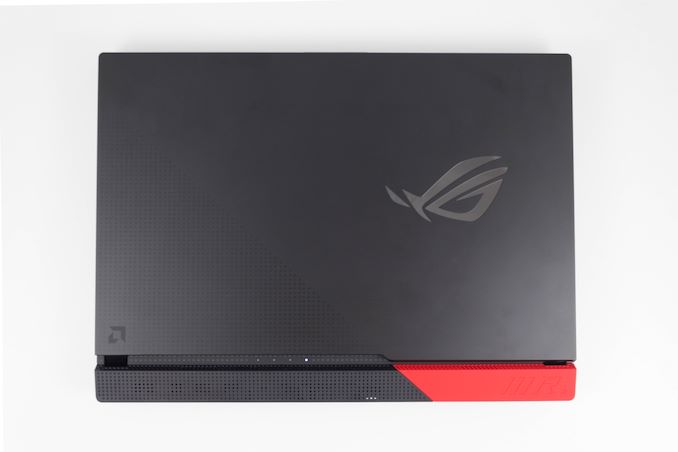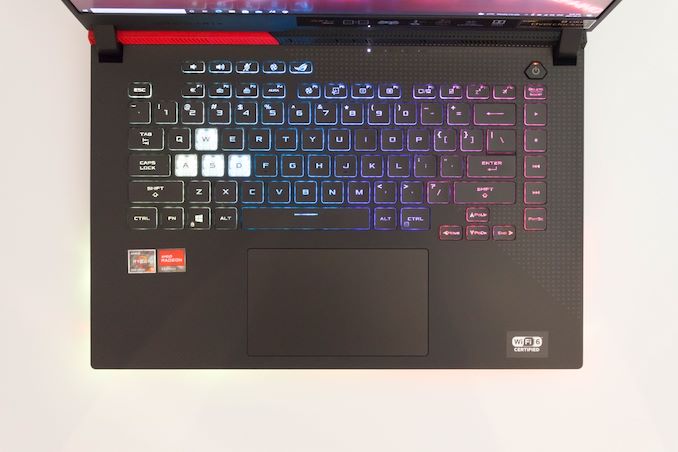The ASUS ROG Strix G15 (G513QY) Review: Embracing AMD's Advantage
by Brett Howse on May 31, 2021 11:00 PM ESTDesign
There are two camps when it comes to gaming notebook design. One group of buyers wants to RGB all the things, and the other prefers a stealthier approach to the design philosophy. ASUS has certainly gone with the former with the Strix G513QY. The big, shiny ROG logo on the top of the notebook, coupled with a bright red accent piece, and RGB Aura lighting around the front, most certainly let everyone know that this is a system for gaming first.
One of the most interesting aspects of the design is the red accent piece on the top left corner. ASUS allows it to be removed, and ships the system with both a chrome, and a translucent black accent, allowing the owner to change it up if they don’t love the red. That’s a nice bit of customization, and although it does not add a lot of the cost of the system, it lets the owner put their own touch on the design.
ASUS also offers incredibly thin 4.5 mm bezels for a 15.6-inch gaming notebook, which really shrinks the form factor down. Unfortunately, as previously mentioned, they did this at the expense of a webcam. They are not the first to do this, but it is an omission that is not ideal, especially in today’s world. Having to buy and use an external webcam with a notebook is a bit of a shame. The hinges are offset from the rear, allowing the laptop chassis to be a bit longer than the display. This prevents the bottom bezel from being extra large, while still allowing the room inside the chassis for cooling components.
One not so great aspect to the design is the finish. ASUS has gone with a matte black finish, and while it does look great, it does pick up fingerprints exceptionally easily. Immediately after opening this review unit, it looked like it had been used for weeks. The design touches, such as the ROG pattern on the keyboard deck, look good, but will be quickly marred by fingerprints and oils.
Moving on to the keyboard, there is a lot to like here. ASUS leverages ROG Overstroke technology, which registers the key press earlier in the stroke compared to a traditional laptop scissor switch, and this makes the keyboard more responsive. For professional gamers, this may make a difference in gaming, but regardless, they keys work very well, and they offer a smooth key press, with great feedback. They key caps provide a slight bit of traction as well, making your fingers press the keys with a bit more ease. This is an excellent keyboard.
Keyboard lighting, at least on this model is four zone RGB, which is always a bit odd. Per-key RGB allows the user to set certain keys to a certain color, making them easier to find, but four zone is always a strange looking effect. You can of course set it to just a single color, or using the included software, cycle through a variety of not always successful strobe effects, if you prefer. The WASD keys are a transparent plastic, which makes them pop quite a bit and is a nice design point.
But the keyboard does not stop there. ASUS has outfitted an IR sensor under the “K” key, which monitors the temperature of the keyboard. If it is getting too toasty to use, cooling can be increased to compensate. ASUS targets a temperature under 40°C for the keys.
For additional lighting, ASUS also includes a light bar on the front of the unit, which projects a nice colored ambient lighting around the front of the laptop.
ASUS has increased the size of the trackpad, and it worked well in limited testing. The surface is very smooth, although like the laptop finish, it is very susceptible to fingerprints as well, so quickly looks grimy.
A lot of the I/O on the ASUS Strix G513QY is on the rear of the device, which makes cable management much easier than devices which just put the ports on the side. Power, Ethernet, HDMI, and some of the USB are on the back, while the left side just features two USB Type-A ports, and a headset jack. There are no ports on the right side, although there is a cooling vent.
Overall, the ASUS ROG Strix G513QY, despite being a mouthful to say, is a compact, well-built, and interesting design. ASUS has gone all out on the gamer look, while also allowing the owner to customize the look with lighting, and even removable accents. The design is compact thanks to the thin display bezels, and they keyboard is one of the best in any gaming notebook. The design is not perfect though. The lack of a webcam is an odd choice in the current climate, and the finish does get dirty very quickly.

















146 Comments
View All Comments
eva02langley - Tuesday, June 1, 2021 - link
Not interested into anything not 1440p, IPS, 144Hz, top color accuracy and Freesync... AMD promised that on stage yesterday... WTH does Asus smoke...!!!???eva02langley - Tuesday, June 1, 2021 - link
Even you guys admit that ASUS SCREWED up not going 1440p. How awesome... ASUS was already on my blacklist for the disaster the G73JH-A1 was... but this is just ridiculous, they are joke as system implementer. They proved it by their incompetence."AMD targets the Radeon RX 6800M at 2560x1440, and for good reason. As we have seen, in pretty much every title, it is completely CPU bound at 1920x1080, even with the newest Ryzen 9 5900HX as the processor. The synthetic tests, as well as the UHD resolution results, really prove this point.
Although there is certainly a market where the 1920x1080 resolution is desired for the lowest latency, in this system, that panel is really too low of a resolution for such a powerful GPU, and it becomes wasted money spent."
eva02langley - Tuesday, June 1, 2021 - link
Well, i just realized that there is a 1440p panel also... however this 1080p version should not even exist. A 1440p panel resolution can be scaled to 1080p if required... so what is the point? 300Hz??? In optimal gaming scenario at 300Hz constant, you gain 4ms of response.As a comparative, 4ms is the equivalent of ONE FPS.... from 250Hz-251Hz... only idiots will defend this stupidity.
eva02langley - Tuesday, June 1, 2021 - link
Ah, I made a mistake in the calculation. The difference is more in the realm of 50 FPS at a 120Hz basis. So basically, 120Hz to 170Hz is the same amount of time from 144Hz to 300Hz.Makes more sense. But still, 50Hz from 120Hz is worth the same than 144Hz to 300Hz. Meaning those 50Hz are worth those 156Hz. This is because FPS are not a linear factor and a ratio.
Spazosaurus - Tuesday, June 1, 2021 - link
Perhaps the next generation of gpus will have enough power to render even the most demanding titles at 2k60 baseline, at which point I'll happily embrace 2k laptop displays. Native 1080p,to me, looks much better than 1080p on a 2k display. Personally I prefer a lower res native display so that I can crank up the quality settings. Once I'm over 60fps, it does not matter if I'm cpu bound or not. I'm not going to lower a native 2k display to 1080p to get 60fps.Spunjji - Friday, June 4, 2021 - link
This GPU isn't going to have any problems rendering any modern titles in 1440p at more than 60fps - at least, not unless you use RT...DanaGoyette - Tuesday, June 1, 2021 - link
I initially thought: ooh, real home, pageup, pagedown, and end keys... But nope, the right column is media playback control keys, and those text cursor control keys are hidden behind Fn.I guess I'm sticking with my HP Omen.
Pacinamac - Tuesday, June 1, 2021 - link
Competition is the best thing for the consumer. Doubt I'll get an AMD system (I'm a video editor who uses quicksync) but happy to see them doing so well.jenesuispasbavard - Tuesday, June 1, 2021 - link
I'm confused with these GPU tests. Comparisons to the competition at only 1080p? Only this laptop's performance at 4K (no comparisons)? 3DMark Fire Strike - which is *eight* years old now; and no Time Spy or Port Royal? 3DMark total score and not GPU score?ksec - Tuesday, June 1, 2021 - link
Why did they not call it Amdvantage is beyond me.